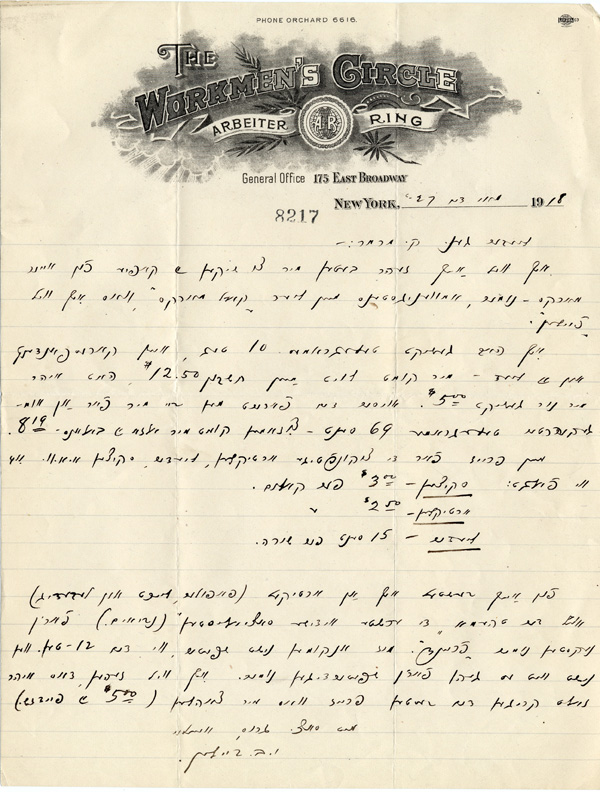Di gantse velt af a firmeblank: The World of Jewish Letterheads
There has been little attention paid to the history of letterhead, the pre-printed stationery used almost everywhere by companies, institutions, organizations, and individuals for correspondence. According to "The History of Letterhead," the first use of the term in English was in 1890, as a new commercial term for printed letter paper. Despite the fact that letterhead has been around for over a hundred years, little has been written about it. And its use is on the wane, as correspondence increasingly becomes electronic and no longer involves actual paper.
But before the letterhead sunsets forever into history, it’s worth another look, particularly examples from its heyday, the late 19th and early 20th century, when graphic design of letterhead was particularly expressive and ornate. Before the Internet, before even use of the telephone was widespread, correspondence was the primary form of communication in both commercial and personal life.
This was no less true for the Jewish world. Assemble the letterheads of Jewish organizations, institutions, and individuals in Europe, North and South America, and Palestine from the 1890s to the eve of World War II in 1939 and you have a portrait of the Jewish world: transnational; diverse in language, political, and religious orientation; and flourishing.
Our new feature, Di gantse velt af a firmeblank (The Whole World on a Letterhead) is an experiment in building that portrait. We hope to bring you, every week, a different example of letterhead from a single collection in the YIVO Archives, the Papers of Kalman Marmor.
Marmor, a Yiddish writer and cultural activist, was born October 11, 1879 in Mayshigola, Vilna Gubernia (today Maišiagala, Lithuania). In 1906, he settled in the U.S. Initially active with the Labor Zionist movement, he later became a Communist. He was an organizer of the 1937 World Yiddish Culture Congress, cultural director of the International Workers Order, and a contributor to the Communist Yiddish newspaper, Morgn Frayhayt. Between 1933 and 1936, he lived in Kiev, where he worked at the Institute of Jewish Proletarian Culture and prepared scholarly editions of the work of American Yiddish poets and writers. During Stalin's Great Terror, the Institute was liquidated, and much of its leadership was arrested and executed. Marmor, an American citizen, returned to the U.S. He died in Los Angeles in 1956.
His papers at YIVO contain several thousand letters from the turn of the 20th century to the 1950s. He had an astonishingly diverse array of correspondents, not limited to Zionist and Communist activists.

From Y. B. Beylin (Beilin) of the Workmen’s Circle, New York to Kalman Marmor, May 27, 1918. (RG 205, Folder 101).
The Workmen’s Circle (Der arbeter ring) is an immigrant, socialist organization founded in New York in 1900, which grew to include numerous branches in North America, and offered its members health benefits, cultural and educational programs, summer camps, and more. In 1918, it had headquarters in the same building with the daily Yiddish newspaper, the Forverts (Forward) at 175 East Broadway on the Lower East Side.
In this letter, Beylin asks Marmor to send him a copy of the “Marx issue” of a publication (possibly Der yidisher kemfer - Jewish Fighter, the journal of the Yidisher natsyonaler arbeter farband - Jewish National Workers Alliance, a Yiddish-speaking Labor Zionist organization in North America affiliated with the Po’ale Tsiyon party), “or at least a copy of my poem, ‘Karl Marx’.” He complains about not having been paid back for expenses, such as postage and telegrams and quotes his fees for future articles, plays, and poems. He also asks Marmor to contribute an original article (“popular, light, lively”) called “The First Jewish Socialists (the Prophets)” to the next issue of Der fraynd (The Friend), the official organ of the Workmen’s Circle.
Series curated by Roberta Newman; Images digitized by Vital Zajka. With thanks to Edward Portnoy. (This is a corrected version of the post that originally appeared on September 19, 2014.)